Section 1: Agency overview and resources
1.1 Strategic direction
The Australian Bureau of Statistics (ABS) is Australia's central statistical agency. It provides statistics on a wide range of economic, environmental and social matters covering government, business and the community. The ABS's mission is to assist and encourage informed decision making, research and discussion within governments and the community by leading a high quality, objective and responsive national statistical service.
The ABS's legislated functions include:
- operate as Australia's central statistical authority for the Australian Government and, by arrangements with the Governments of the States, provide statistical services for those Governments;
- collect, compile, analyse and disseminate statistics, and related information; and
- coordinate the statistical operations of official bodies with particular regard to:
- the avoidance of duplication of statistical information;
- the attainment of compatibility and integration of statistics compiled by official bodies;
- the maximum utilisation of information available to official bodies for statistical purposes;
- the development of standards for statistics and ensuring that official bodies comply with them;
- the provision of advice and assistance to official bodies on the production and use of statistics; and
- liaison with international organisations on statistical matters.
To achieve the ABS's mission, the ABS will continue to provide quality and relevant statistics over the forward triennium within the budget allocated to it. This includes ensuring that the statistics released by the ABS address current issues. The ABS will continue to undertake significant engagement with stakeholders in order to understand their needs with the aim of better responding to those needs. The ABS will also work with other agencies to provide the next generation of statistical requirements and information management infrastructure.
The ABS will continue to work with data providers to access alternative sources of information that can be used for statistical purposes, especially administrative data held by other government agencies. Access to this data will be managed carefully to ensure that providers are aware of the excellent protection the ABS's legislation affords their data. This will manage public perceptions about privacy issues, and maintain the trust of providers.
The ABS will also continue to provide leadership of the National Statistics Service (NSS). The NSS is the community of government agencies at Australian, state and territory levels, led by the ABS, which seeks to build a better statistical service for the community. For example, the ABS will be actively building relationships with other government agencies and will target areas to progress the NSS, such as statistical frameworks, principles and data sources that can be used to produce official statistics. The objective of the NSS work is to improve and expand the information available for decision making regardless of its source. The NSS work encapsulates the coordination functions set out in the ABS legislation and will be critical to reducing duplication across government agencies, increasing coherence of official statistics, reducing provider load and ensuring a less fragmented statistical system.
The ABS will support data integration for statistical and research purposes. The demand for linking social, economic and environment datasets continues to increase across Australian governments. The ABS is working with Australian governments to improve the strategic use of data assets whilst preserving community trust in the process and confidence in the statistics and research produced.
The ABS will also be paying particular attention to ensuring the sustainability of its operations by developing better ways for organising its work including how best to secure its future workforce.
The key external drivers of and challenges for the ABS work program include:
- the need for evidence-based and coordinated policy and program delivery initiatives across departments and jurisdictions driven by organisations such as the Council of Australian Governments;
- increasing complexity of the Australian economy and society which complicates the production of existing statistics (for example, issues such as globalisation are placing additional demands on the production of relevant economic and social statistics);
- increasing pressure to produce new and or more detailed outputs which must be balanced with the need to maintain stable time series for longitudinal analysis and with the need to maintain the trust of providers;
- a wider range of sources of statistical data driving a need to ensure that the overall NSS is coordinated and the ABS's role is clearly defined;
- increasing demands for simplified interactions with government, including with the ABS. This is supported by a federal government agenda that emphasises reductions in 'red tape' and greater information sharing (create-once, use-many);
- increasing demands for access to microdata, data relating to particular population groups, longitudinal data and linked data (while acknowledging concerns about individual privacy); and
- pressures to improve productivity and to create a staff profile more appropriate to the ABS's future skill needs in an increasingly tight labour market where attraction and retention issues are presenting significant challenges.
1.2 Agency resource statement
Table 1.1 shows the total resources from all sources. The table summarises how resources will be applied by outcome and by departmental classification.
Table 1.1: Australian Bureau of Statistics resource statement — Budget
estimates for 2011-12 as at Budget May 2011
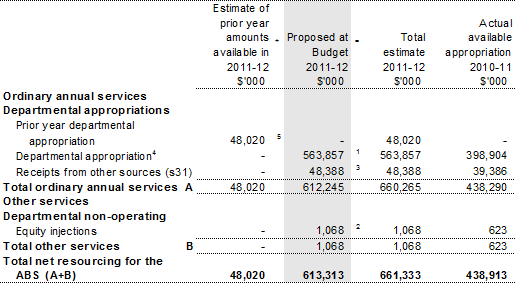
1. Appropriation Bill (No.1) 2011-12.
2. Appropriation Bill (No.2) 2011-12.
3. Receipts received under s31 of the Financial Management and Accountability Act 1997.
4. Includes an amount of $18.0 million in 2011-12 for the departmental capital budget (refer to Table 3.2.5 for further details).
5. Estimated adjusted balance carried forward from previous year.
1.3 Budget measures
Budget measures relating to the ABS are detailed in Budget Paper No. 2, Budget Measures 2011-12 and are summarised below.
Table 1.2: Australian Bureau of Statistics 2011-12 Budget measures
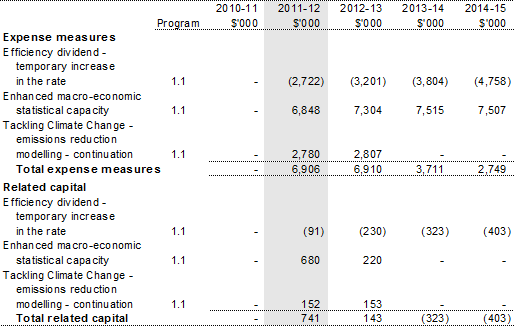
Prepared on a government finance statistics (fiscal) basis.
Section 2: Outcomes and planned performance
2.1 Outcomes and performance information
Government outcomes are the intended results, impacts or consequences of actions by the Government on the Australian community. Commonwealth programs are the primary vehicle by which government agencies achieve the intended results of their outcome statements. Agencies are required to identify the programs which contribute to Government outcomes over the budget and forward years.
The ABS's outcome is described below specifying the strategy, program, objective, deliverables and key performance indicators used to assess and monitor the performance of the ABS.
Outcome 1: Informed decisions, research and discussion within governments and the community by leading the collection, analysis and provision of high quality, objective and relevant statistical information
Outcome 1 strategy
Key strateg
ies for 2011-12 to 2013-14 are set out in the ABS Forward Work Program. The major initiatives that will contribute to this outcome over this period include:
- assist and encourage informed decision making through continued delivery of relevant high quality, key official statistics;
- ensure maximum use of, and access to, official statistics, by actively building relationships and targeting specific areas to progress the NSS;
- meet provider expectations through continued standardisation and harmonisation of data collection requirements and methods across the Australian government, including through e-data initiatives; and
- ensure international statistical coherence by influencing the development and implementation of statistical standards and frameworks of relevance to the region through the ABS's leadership role in international statistics strategy.
Outcome expense statement
Table 2.1 provides an overview of the total expenses for Outcome 1.
Table 2.1: Budgeted expenses for Outcome 1
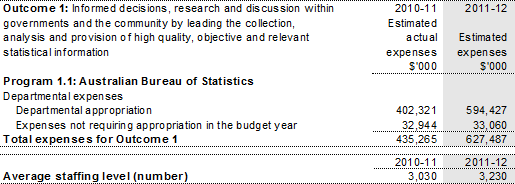
Contributions to Outcome 1
Program 1.1: Australian Bureau of Statistics
Program objective
The ABS has the following objectives:
- an expanded and improved NSS;
- to provide services that are timely, relevant, responsive and respected for their integrity and quality;
- informed and increased use of statistics;
- to be a key contributor to international statistical activities that are important to Australia or to the region;
- to be an organisation that builds capability to continually improve its effectiveness;
- to have the trust and cooperation of providers; and
- to be a respected and strongly supported organisation.
Program expenses
The increase in expenses for 2011-12 are predominately due to the 2011 Census of Population and Housing (2011 Census) cyclical funding, budget measures and rendering of services.
Table 2.2 Program expenses

Program deliverables
The ABS deliverables are:
- provide a range of quality and timely statistical outputs across key economic, population, social and environmental subject matters that meet the needs of key users;
- conduct, and commence processing of, the 2011 Census;
- undertake an ongoing engagement process with external stakeholders to facilitate ongoing improvements to the relevance, reliability and accuracy of the ABS statistical program;
- influence the development and implementation of statistical standards and frameworks across the world; and
- progress the NSS by expanding and improving the statistical information available for decision making regardless of its source.
Program key performance indicators
The ABS key performance indicators are:
- an objective statistical service as demonstrated by:
- release of reliable and accurate statistics;
- transparent statistical process; and
- trust and cooperation of providers.
- statistical output which meets the needs of key users of economic and social data in terms of:
- support for decision-making; and
- a high level of use.
- appropriate use of statistical standards, frameworks and methodologies by:
- leading the development of national statistical standards, frameworks and methodologies, and their implementation within the broader Australian statistical system; and
- contributing to the development of key international standards, frameworks and methodologies, and implementing them as appropriate.
Section 3: Explanatory tables and budgeted financial statements
Section 3 presents explanatory tables and budgeted financial statements which provide a comprehensive snapshot of agency finances for the 2011-12 budget year. It explains how budget plans are incorporated into the financial statements and provides further details of the reconciliation between appropriations and program expenses, movements in administered funds, special accounts and government Indigenous expenditure.
3.1 Explanatory tables
3.1.1 Movement of administered funds between years
The ABS does not have any administered funds.
3.1.2 Special accounts
Special accounts provide a means to set aside and record amounts used for specified purposes. Special accounts can be created by a Finance Minister's Determination under the Financial Management and Accountability Act 1997 (FMA Act) or under separate enabling legislation. Table 3.1.2 shows the expected additions (receipts) and reductions (payments) for each account used by the ABS.
Table 3.1.2 Estimates of special account cash flows and balances
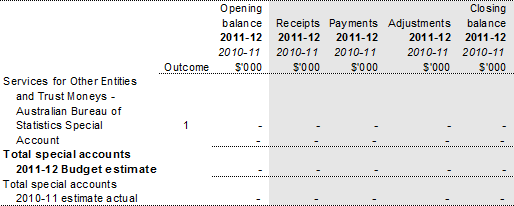
3.1.3 Australian Government Indigenous Expenditure
The ABS does not have any Australian Government Indigenous Expenditure.
3.2 Budgeted financial statements
3.2.1 Differences in agency resourcing and financial statements
The difference between the agency level resource statement and the sum of all outcome resource statements is the expected carry-forward amount of resources for the budget year 2011-12, including amounts related to meeting future obligations to maintain the agency's asset base and to meet employee entitlement liabilities.
3.2.2 Analysis of budgeted financial statements
Budgeted financial statements
The change in appropriation in 2011-12 reflects an increase in activity relating to the 2011 Census and new measures arising from the 2011-12 Budget. A listing of these measures is provided at Table 1.2.
Goods and services revenue in 2011-12 and the forward years reflects the expected services to be rendered, with the increase being primarily due to work funded by the Department of Health and Ageing.
The estimated actual 2010-11 operating deficit represents a technical accounting loss resulting from the change in accounting estimates for internally generated software. This will result in an increase in employee benefits expenditure and a reduction in internally generated software capitalised as reported in the balance sheet.
3.2.3 Budgeted financial statements tables
Table 3.2.1: Comprehensive income statement (showing net cost of services)
(for the period ended 30 June)
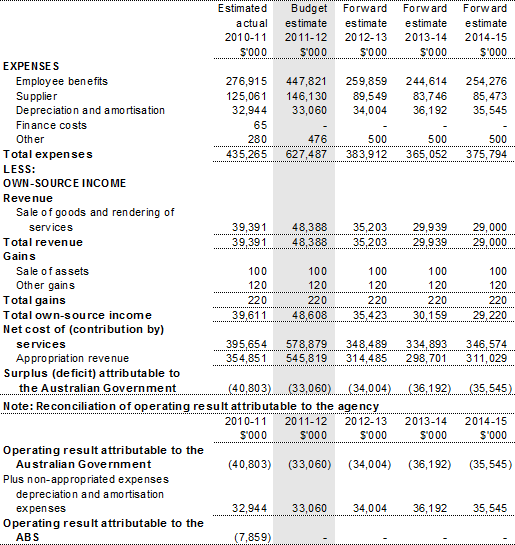
Prepared on Australian Accounting Standards basis.
Table 3.2.2: Budgeted departmental balance sheet
(as at 30 June)
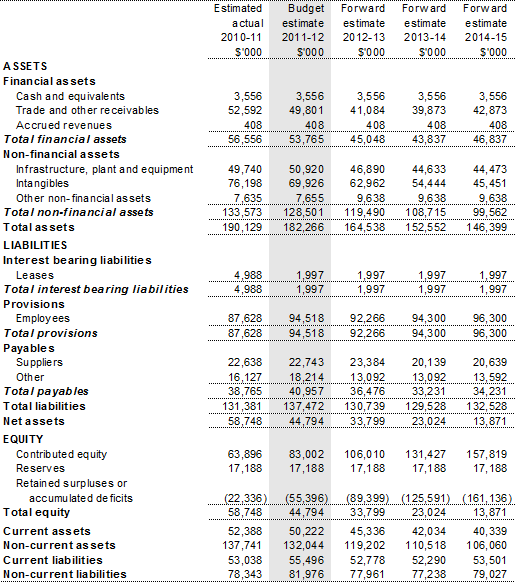
Prepared on Australian Accounting Standards basis.
Table 3.2.3: Budgeted departmental statement of cash flows
(for the period ended 30 June)
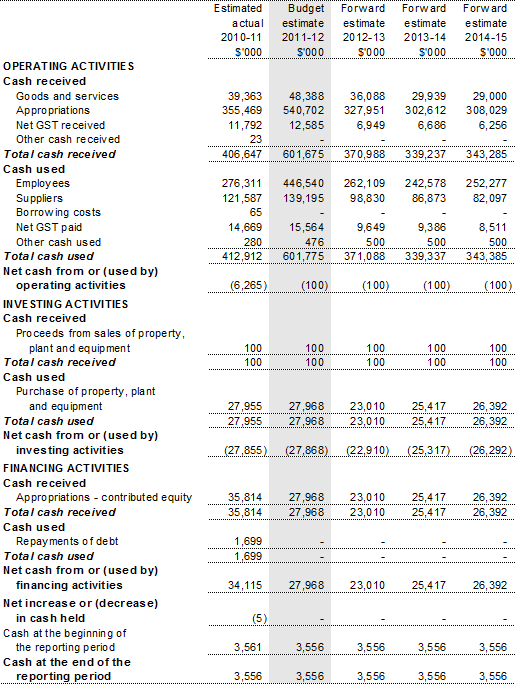
Prepared on Australian Accounting Standards basis.
Table 3.2.4: Departmental statement of changes in equity — summary of movement
(budget year 2011-12)
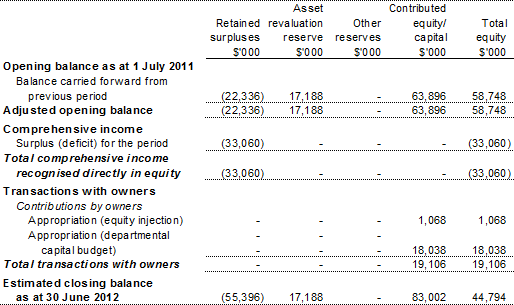
Prepared on Australian Accounting Standards basis.
Table 3.2.5: Departmental capital budget (DCB) statement
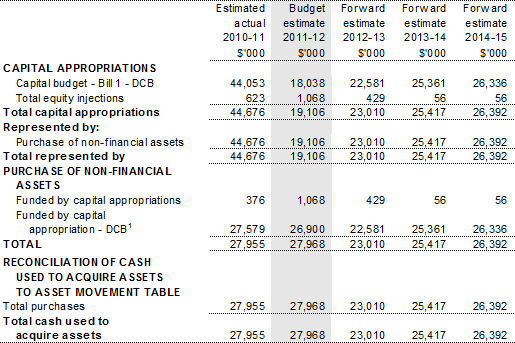
1. DCB funding of $8.862 million will be carried over from 2010-11 to fund 2011-12 purchases.
Prepared on Australian Accounting Standards basis.
Table 3.2.6: Statement of asset movements (2011-12)
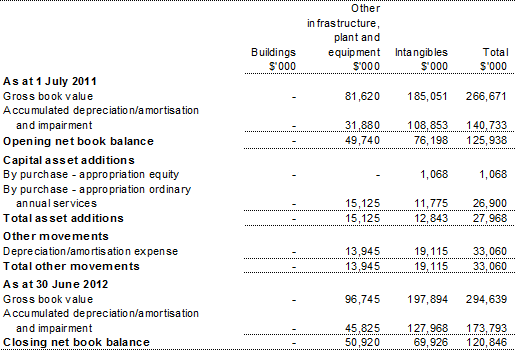
Prepared on Australian Accounting Standards basis.
3.2.4 Notes to the financial statements
Basis of accounting
The agency budget statements have been prepared on an accrual basis and in accordance with historical cost convention, except for certain assets, which are at valuation.
Budgeted departmental financial statements
Under the Australian Government's accrual budgeting framework, and consistent with Australian Accounting Standards, transactions that agencies control (agency transactions) are budgeted and reported separately from transactions agencies do not have control over (administered transactions). This ensures that agencies are only held fully accountable for the transactions over which they have control.
Agency assets, liabilities, revenues and expenses in relation to an agency are those that are controlled by the agency. Agency expenses include employee and supplier expenses and other administrative costs, which are incurred by the agency in providing its goods and services.
Budgeted departmental income statement
Revenues
Appropriations
The ABS is appropriated from government for its program.
Sale of goods and rendering of services
Revenue is derived from the sale of ABS publications and census data, as well as the provision of user-funded surveys and consultancy work. The amount of revenue earned in any one year is dependent upon the demand for such products and services by government agencies, business and the community.
Other gains
This category includes resources received free of charge.
Expenses
Employee benefits
This includes wages and salaries, superannuation, provision for annual leave and long service leave, and workers compensation. Employee entitlements are based on leave patterns of ABS employees. Accrued salaries and employer superannuation contributions are based on daily salary expense and the number of days owing at 30 June in each budget year.
Depreciation and amortisation
Depreciable assets are written off over their estimated useful lives. Depreciation is calculated using the straight-line method, which is consistent with the consumption of the service potential of the depreciable assets of the ABS.
Budgeted departmental balance sheet
Non-financial assets — intangibles
These include software developed in house (internally generated software).
Non-financial assets — other
This category includes prepayments.
Interest bearing liabilities — loans
The ABS received a loan of $13.2 million in 2001-02. This loan was used to partially fund the fit-out of the ABS's new national office accommodation. Loan repayments will be made over a ten year period and are being met by the ABS from within its ongoing operational funding levels. The loan has been fully repaid in 2010-11.
Interest bearing liabilities — other
These include lease incentives in the form of a rent free period and/or a contribution to fitout costs. Lease incentives are recognised as a liability, which is reduced by allocating lease rental payments between interest, rental expense and reduction of the liability. Rent free lease periods are taken up as a liability during the rent free period and amortised over the remaining term of the lease. The full amount of the lease is therefore allocated evenly over the total term of the lease.
Provisions — employees
The liability for employee entitlements includes provision for annual leave and long service leave. No provision has been made for sick leave, as all sick leave is non-vesting.
The non-current portion of the liability for annual leave and long service leave is recognised and measured at the present value of the estimated future cash flows in respect of all employees.
Payables
Supplier and other payables reflect the amounts owed to trade and other creditors by the ABS at the end of each financial year.
Asset valuation
Australian Government agencies and authorities are required to value property, plant and equipment and other infrastructure assets using the fair value method of valuation. This essentially reflects the current cost the entity would face in replacing that asset.